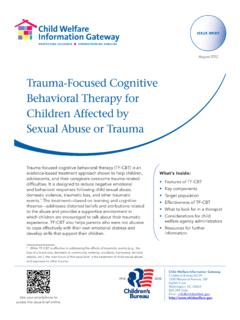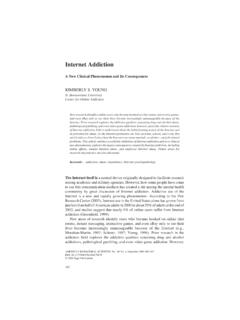Transcription of The Psychology of Pain - UW Hematology Protocols
1 Emerg Med Clin N Am 23 (2005) 339 348. The Psychology of pain George R. Hansen, MDa,*, Jon Streltzer, MDb a Department of Emergency Medicine, Sierra Vista Regional Medical Center, 1010 Murray Avenue, San Luis Obispo, CA 93405, USA. b Department of Psychiatry, John A. Burns School of Medicine, University of Hawaii, 1356 Lusitana Street, Honolulu, HI 96813, USA. The perception of pain involves far more than mere sensation. The a ective and evaluative components of pain are often as important as the production and transmission of the pain signal. These emotional aspects are most prominent in chronic pain patients, but knowledge of the Psychology of pain can greatly improve the treatment of acute pain as well.
2 pain and its perception The limbic system, where emotions are processed, modulates the amount of pain experienced for a given noxious stimulus. It has been shown in cancer patients [1] that the a ective component of pain can be completely blocked by frontal lobectomy. Lobectomized patients still register severe pain , but it doesn't bother'' them. pain can thus be viewed as merely a signal'' that something is wrong somewhere in the body, until it reaches the emotional brain, where this signal becomes what we feel as pain . The emotional response to pain involves the anterior cingulate gyrus and the right ventral prefrontal cortex.
3 These centers are also activated by social rejection. Serotonin and norepinephrine circuits are also involved in the modulation of sensory stimuli, which probably in uence how depression and antidepressant medications a ect the perception of pain [2]. Context The perception of even acute pain is highly dependent on the context in which it occurs [3]. It has been found that the pain perceived in battle * Corresponding author. E-mail address: ( Hansen). 0733-8627/05/$ - see front matter 2005 Elsevier Inc. All rights reserved. 340 HANSEN & STRELTZER. wounds bears little relationship to the extent of the wounds [4].
4 There are reports of soldiers in battle who su er a compound fracture, and report only twinges of pain [5]. In laboratory studies of experimental pain in which context, fear, and anxiety are controlled, the placebo e ect and opioids are much less e ective. This occurs because the reduction of both the fear and anxiety is a large part of the placebo e ect and of the function of opioids [6]. Attention Focusing one's attention on pain makes the pain worse [1]. Patients who have somatic preoccupation or hypochondriasis are overvigilant about bodily sensations. It has been found that by attending to these sensations, they amplify them to the point of feeling painful [7].
5 Conversely, distracting patients is highly e ective in reducing their pain . Burn patients undergoing treatments or physical therapy experience excruciating pain , even after they have been given opioids. It has been shown that these patients report only a fraction of this pain if they are distracted with a virtual-reality type of video game during the procedure [8]. Anxiety Anxiety, fear, and a sense of loss of control contribute to patient su ering. Treating anxiety and providing psychological support has been shown to improve pain and reduce analgesic use. Improving patients' sense of control and allowing them to participate in their care is also helpful [9].
6 Physicians should try to create an environment that is nonthreatening. For procedures, prepare needles and other equipment out of sight from the patient. In addition to assuring that procedures are performed in the least painful way possible, use nonthreatening terms such as mild discomfort''. instead of pain .'' It is also helpful to distract patients with conversation about subjects that interest them, such as their hobbies or family [10]. Memory Patients who have low levels of pain remember it as being worse than they originally reported, which tends to worsen with time. Almost all patients report relief with treatment, even when true measured changes in pain scale are not signi cant, and sometimes when measured pain is worse [11].
7 Learned pain pain can be a learned response, rather than a purely physical problem. Just as cancer patients can develop nausea as a learned response to Psychology OF pain 341. treatment and experience it even before chemotherapy is administered, patients can learn to have pain even in the absence of a physical stimulus [12]. In some cases, pain can be entirely in the mind,'' as in the case of a butcher who slipped and caught his arm on a meat hook, and was reported to be su ering in great agony. When he learned that the hook had merely caught on his sleeve and his arm was uninjured, his pain resolved [13].
8 Patients can learn to feel di erent amounts of pain just by viewing other people. When laboratory subjects were shown models demonstrating high pain tolerance, they required times greater stimulus before they rated it as painful, compared with those subjects who observed models who showed poor tolerance. Nonaversive shock, usually described as tingling,'' was rated as painful by only 3% of those who had viewed a tolerant model, compared with 77% of the subjects who viewed models who showed poor tolerance [14]. Expectations Patients' expectations of how much pain they should have also in uence how much pain they feel, their response to treatment [15], and whether or not the condition becomes chronic and disabling.
9 The results of minor whiplash injuries have been shown to be highly variable in di erent regions. This has been attributed to the local cultures and expectations. Any mes- sages that communicate to patients that they have a serious or debilitating injury may contribute to deconditioning and maladaptive postures that worsen their pain . Prescribing medications can contribute to the problem. Patients who are not given sick leave and are told to act as usual'' have much better outcomes [7]. The placebo e ect is also in uenced by patients' and physicians'. expectations [15]. It can be assumed that the nocebo'' e ect (ie, the perception of harm resulting from a patient's beliefs) can also result from messages that inadvertently increase the patient's anxiety and expectations of pain .
10 Beliefs and coping Other psychosocial issues, such as what patients believe about their pain [16,17], their coping skills [18 21], their tendency to catastrophize''. [17,18,20], self-e cacy [17], locus or control [22], and their involvement in the sick role'' [13], all have an impact on how much pain patients feel, and how it a ects them. In successfully getting low back pain patients back to work, the most important factor identi ed has been a reduction in subjective feelings of disability [23]. Patients diagnosed with bromyalgia have to stop catastrophizing to improve, and they must be persuaded that they have 342 HANSEN & STRELTZER.







